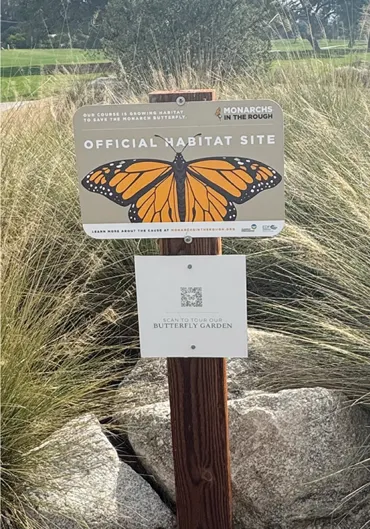More Green, Less Grass

Temecula Creek tackles sustainability in big and little ways that reflect respect for the land — and its original inhabitants
Golf course superintendents have plenty of motivation for implementing sustainable practices: saving water, saving money, saving the image of the game.
But for Brett Wininger, course super at Temecula Creek GC (TCGC), it boils down to something more basic: doing the right thing. True, Wininger’s innovations at TCGC have saved water and money. But take, for instance, the 9,000-square-foot monarch butterfly habitat that borders the Oaks course just outside the clubhouse and Corkfire Restaurant.
“I just love butterflies,” Wininger says. “And I’m a total plant nerd. I can bring my kids here and show them how nature works.”
Plant-nerd Wininger is a graduate of Cal Poly Pomona with a degree in landscape architecture. “That started my environmentally friendly mindset,” Wininger says, “which became a passion. When I took this job, I saw 150 acres of opportunity — for example, to reduce turf.” In other words, to do the right thing everywhere possible. A tour of Temecula Creek GC bears that out.
MONARCHS REIGN
The Monarchs in the Rough habitat replaced 8,000 square feet of turf with a variety of native plants such as butterfly bush, Californian poppy, coneflower, yarrow, lantana and, of course, milkweed, which is the only plant that endangered monarchs will lay their eggs on.
“Everything here has a purpose,” Wininger says, as he gestures to three citrus trees. “Those will never be harvested. We want that fruit to drop and decay and create a secondary food source for the butterflies.”

There’s a bit of serendipity going on, too, as a big blue elderberry bush established itself in the middle of one of the habitat beds. Elderberry is sacred to the Pechanga tribe — owners of Temecula Creek GC and adjacent Temecula Creek Inn — as well as alluring to butterflies.
If 8,000 square feet of turf doesn’t sound like a lot, listen to Wininger tick off the math:three irrigation heads watering 240 gallons a minute about 10 minutes per summer night adds up to almost 250,000 gallons a year saved by giving a bit of fairway flank over to an endangered species. Want to learn more? Scan the QR code on a sign in the garden and enjoy an interpretive tour hosted by Wininger himself.

SACRED OAKS
Blue elderberry is not the only native flora at TCGC that is sacred to the Indigenous Pechanga people. The magnificent Coast Live Oak trees that line the Temecula Creek’s three nine-hole courses are venerated by the tribe.
“Oak trees to us are sacred,” says Gary Dubois, director of the Pechanga cultural resources department. He explains that the first-born of the creators of the world “took the form of not only humans, but animals, oak trees, boulders and cottonwoods.”
Oak trees, though, are not big fans of irrigation. California oaks are adapted to the state’s drought cycle — which is why Wininger is methodically establishing oak tree protection zones throughout the course. Starting with the Oaks course (naturally), TCGC is removing turf from around the oaks and replacing it with wood-chip mulch salvaged from downed pine trees and fallen branches. The oaks thrive without regular irrigation, and the course saves a lot of water in the process. The oak tree protection program has so far removed more than 130,000 square feet of turf.
GARDENS OF DELIGHT
Not far from the butterfly garden, just outside the pro shop, is a plot planted for human consumption. The one-acre chef’s garden has repurposed a portion of the No. 1 tee box— not only for seasonal organic produce to supplement the larder of chef Ben Diaz’s Corkfire Kitchen, but also for an intimate event space. The garden also serves an educational purpose for at-risk youth who visit from nearby Oak Grove Center.
Farther along, near the far end of the Oaks No. 2 fairway, is what Wininger calls the farm extension: 23,000 square feet of carefully tended seasonal veggies. I noticed artichokes, strawberries and kale; you may see leafy greens, peppers, squash and pumpkins. I also noted something highly unusual for a golf course: a pet station dispensing doggie poop bags. Not that canines are out on the fairways. What the pet station signifies is a two-mile hiking/jogging trail that circles the Oaks course, allowing nongolfers and their best friends to enjoy the beauty of the setting.
RECLAIMED & ACCLAIMED
Like any SoCal course super, Brett Wininger is concerned about water. Fortunately, the course is able to utilize highly-treated reclaimed water piped in to two retention ponds by the Rancho California Water District. Wininger also utilizes a cutting-edge arsenal of water-savers, such as portable and fixed moisture sensors.
“Knowing the water content of the soil can tell me when it’s time to irrigate — holding off for just a day can save 400,000 gallons of water.”
He also uses environmentally friendly turf treatments that help retain moisture and minimize transpiration.
It should come as no surprise that Temecula Creek Inn shares the golf course’s sustainability ethos: no single-use plastic bottles (plenty of water refill stations instead), paperless transactions in the restaurant and pro shop, copious composting, low-flow water fixtures.
Little things add up: The course and the inn’s combined efforts garnered them the Good Earthkeeping Award from the California Hotel Lodging Association. All for doing the right thing.











